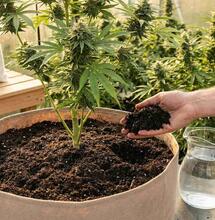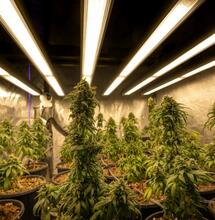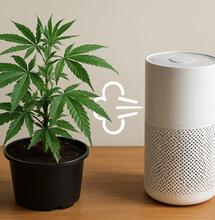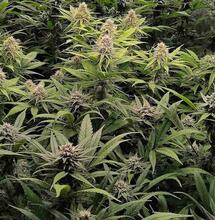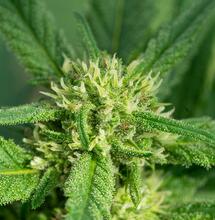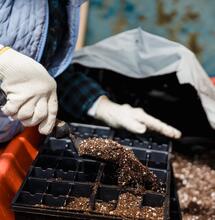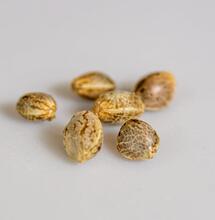Growing Cannabis With Nutrient Film Technique
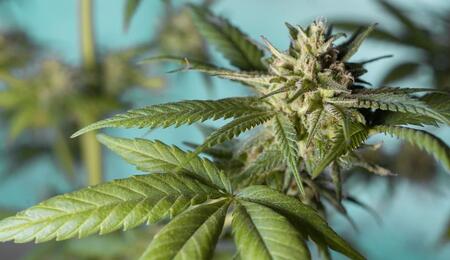
While the idea of growing pot hydroponically is intimidating for some, an NFT setup can actually save you time, effort and money. In this article, learn all about the benefits of growing cannabis with the so-called Nutrient Film Technique and why it’s worth trying this method once you accumulate some growing experience.
Many home growers love growing with compost and pots and it is easy to see why - pots are simple to use and cheap to set up. Compost is also very forgiving and will buffer against pH fluctuations and overfeeding. Best of all, you can achieve some damn fine yields with compost and pots - plus, sometimes it just feels good to get your hands dirty!
When you are just starting out, you have enough to deal with in trying to sort out your growing environment and learning how your plants react to different levels of light, food and training. However, once you have your environment dialed-in and you are happy with your setup, for the ultimate yields, take a look at hydro.
Many growers disregard active hydroponics as too complicated and difficult, preferring to hand-water pots or use passive hydroponic pot systems that require a capillary medium, such as compost or cocos. In reality, active hydroponics can be as straightforward and simple as you make it. When you are about to embark on your next grow and are eying up the options in your local hydroponic shop, ask yourself a few important questions.
Which is Easier:
- Individually hand-watering a grow room full of thirsty plants, or just topping up a single reservoir?
- Transporting bags and bags of heavy media from the shop to the car to your house, or just a small box of rockwool?
- Potting up plants into larger containers several times per crop, or just placing your plants in a hydro system?
Active hydroponic systems may offer lower maintenance, easier setups and a cleaner, compost-free growing environment - not to mention faster harvests and increased yields.
There are plenty of active hydroponic systems out on the market, using many different hydroponic techniques: drip irrigation, flood-and-drain and aeroponics are just a few. However, for simple and effective 'pure' hydroponics - where a minimal amount of growing media is used - take a look at NFT.
NFT or Nutrient Film Technique for Cannabis Growing
NFT stands for 'nutrient film technique', an active hydroponic method where nutrient solution is pumped onto a tray (or, in commercial situations, into a gulley) to create a very shallow, slow moving film that flows through the roots of the plants, providing them with all the elements they need. The roots of the plants grow into the solution and fill the tray or gulley, forming a large root mat.
This constant access to water and nutrients, combined with an abundant supply of oxygen to the roots, means that plants grown in NFT develop very rapidly and produce significantly larger yields than soil-grown plants. This is why it is a preferred method in commercial horticulture.
Now, if we are talking NFT about for the home grower, one system has stood proudly above the rest - that is the NFT Gro-Tank. Which does not mean that there isn't any other model that can convey the task of growing smoothly and very much successfully.
However, the NFT GRO-Tank was the first hydro system developed specifically for the needs of the home grower. Coming out of the UK in the late 1970s, it has been trusted by growers for decades. Simple to assemble and operate with, GRO-Tank systems stand less than one foot off the ground, leaving plenty of room to grow under lights. All of the workings sit above the reservoir, so it will not leak - perfect for the attic, bedroom or growing in an apartment where water dripping through your downstairs neighbor's ceiling is not an option!
Why NFT Over Pots?
- Faster growth rate and bigger yields - expect up to three times the yield of conventional compost growing
- Simplicity - no complicated delivery systems, no feeding schedules to calculate and very little maintenance involved
- Quicker harvests - get more crops per year
- Water efficiency - no waste runoff in re-circulating hydroponic systems
- No chance of over- or under-watering - plants take as much or as little as they need
- Cleaner method, plus minimum waste produced - no heavy bags of medium to carry around, a major benefit for indoor cultivation
- No soil-borne pests - reduced chance of disease and reduced use of pesticides

Three Steps To NFT Heaven:
- Ensure that plants are thoroughly rooted before they go into the system. An abundance of white roots should be visible on the outside of the starter medium; use rockwool for the cleanest possible growing environment. Completely remove the plastic wrapping from the rockwool cubes - this allows the roots access to more oxygen.
- Drape a thin layer of capillary matting known as a 'spreader mat' over the tray. This helps to evenly distribute the flow of the nutrient solution over the entire surface of the tray, while plants are still young. NFT spreader mats can be purchased in a variety of sizes. Cut holes in the top plate, depending upon how you want to space your plants (you can grow lots of small plants or several large plants). Place the plants through the holes on the cover and rest them on the tray.
- Fill the reservoir with water; add nutrients and adjust pH. Run the pump twenty-four hours per day, then sit back and watch them grow! The reservoir will need topping up every few days with half-strength nutrient solution (because plants will use more water than nutrient, therefore you top up with a less concentrated dose) and will need a complete emptying and refill every ten days to keep things fresh.
FAQ From An NFT Grower:
Q: How should plants be spaced?
A: NFT systems such as Gro-Tanks allow growers to space plants however they desire; they can simply cut spacings in the top plate that is provided. As a general rule, try one plant per square foot. This can be increased or decreased depending upon plant variety or technique. Sea-of-green (SOG) works very well in NFT, just space your plants closer together and switch to twelve/twelve as soon as your plants are established in the system (usually within a week).
Q: How high should EC be set?
A: As very little medium is used with NFT, there is no buffer between the roots and nutrient solution. Water and nutrients are available to the plants at all times. Therefore growers are advised to set EC a little lower than they would with other hydro techniques, such as flood-and-drain, or when growing in soil. When transplanting young plants into a Gro-Tank, add nutrients at half the manufacturer's recommended dosage and gradually increase to full strength as plants mature.
Q: What nutrient strength should the tank be topped up with?
A: Plants grown indoors under lights will take up water at a greater rate than nutrient uptake. Over time the EC (CF) of the solution will rise. Therefore it is advisable to top up the tank with half-strength nutrient solution; check the EC and add extra nutrients if necessary.
Q: How often does the nutrient solution need to be changed?
A: Completely changing the solution once every two weeks is recommended. This ensures that plants are receiving an optimum balance of nutrients.
Q: Will plants need to be supported?
A: Yes. NFT is a bare-rooted growing technique. All but the smallest of plants will need additional support (e.g., yoyos or pea netting) - especially when those fruits get big!
What are you waiting for? Give NFT a try!
Also read on Soft Secrets:
